Low-Profile Wideband Dual-Polarized Patch Antenna Based on Differential-Paired Multi-Mode Arms
Abstract
:1. Introduction
2. Antenna Design
2.1. Antenna Configuration
2.2. Tri-Mode Excitation on Each Arm (Arm I~Arm III)
2.3. Gain Improvement with Shorting Pins (Arm IV)
2.4. Impedance Matching Improvement Using Coupling Feed
2.5. Broadband Differential Feeding Network
3. Measured Results and Comparison
4. Conclusions
Author Contributions
Funding
Data Availability Statement
Conflicts of Interest
References
- Luo, Y.; Chen, Z.N.; Ma, K. A single-layer dual-polarized differentially fed patch antenna with enhanced gain and bandwidth operating at dual compressed high-order modes using characteristic mode analysis. IEEE Trans. Antennas Propag. 2020, 68, 4082–4087. [Google Scholar] [CrossRef]
- Liu, N.; Zhu, L.; Choi, W. A differential-fed microstrip patch antenna with bandwidth enhancement under operation of TM10 and TM30 modes. IEEE Trans. Antennas Propag. 2017, 65, 1607–1614. [Google Scholar] [CrossRef]
- Saxena, S.; Kanaujia, B.K.; Dwari, S.; Kumar, S.; Tiwari, R. A Compact Dual Polarized MIMO Antenna with Distinct Diversity Performance for UWB Applications. IEEE Antennas Wirel. Propag. Lett. 2017, 16, 3096–3099. [Google Scholar] [CrossRef]
- Mak, K.M.; Lai, H.W.; Luk, K.M. A 5G wideband patch antenna with antisymmetric L-shaped probe feeds. IEEE Trans. Antennas Propag. 2018, 66, 957–961. [Google Scholar] [CrossRef]
- Wong, H.; Lau, K.-L.; Luk, K.-M. Design of dual-polarized L-probe patch antenna arrays with high isolation. IEEE Trans. Antennas Propag. 2014, 52, 45–52. [Google Scholar] [CrossRef]
- Ryu, K.S.; Kishk, A.A. Wideband dual-polarized microstrip patch excited by hook shaped probes. IEEE Trans. Antennas Propag. 2008, 56, 3645–3649. [Google Scholar] [CrossRef]
- Ghorbani, K.; Waterhouse, R.B. Dual polarized wide-band aperture stacked patch antennas. IEEE Trans. Antennas Propag. 2004, 52, 2171–2175. [Google Scholar] [CrossRef]
- Barba, M. A high-isolation, wideband and dual-linear polarization patch antenna. IEEE Trans. Antennas Propag. 2008, 56, 1472–1476. [Google Scholar] [CrossRef] [Green Version]
- Tang, Z.; Liu, J.; Cai, Y.-M.; Wang, J.; Yin, Y. A wideband differentially fed dual-polarized stacked patch antenna with tunedslot excitations. IEEE Trans. Antennas Propag. 2018, 66, 2055–2060. [Google Scholar] [CrossRef]
- Radavaram, S.; Pour, M. A wideband coplanar L-strip fed rectangular patch antenna. IEEE Antennas Wireless Propag. Lett. 2021, 20, 1779–1783. [Google Scholar] [CrossRef]
- Deng, C.; Li, Y.; Zhang, Z.; Feng, Z. A wideband high-isolated dual-polarized patch antenna using two different Balun feedings. IEEE Antennas Wireless Propag. Lett. 2014, 13, 1617–1619. [Google Scholar] [CrossRef]
- Zhang, K.; Zhu, F.; Gao, S. Differential-fed ultra-wideband slot loaded patch antenna with dual orthogonal polarization. Electron. Lett. 2013, 49, 1591–1593. [Google Scholar] [CrossRef]
- Sun, D.; Zhang, Z.; Yan, X.; Jiang, X. Design of broadband dual polarized patch antenna with backed square annular cavity. IEEE Trans. Antennas Propag. 2016, 64, 43–52. [Google Scholar] [CrossRef]
- White, C.R.; Rebeiz, G.M. A differential dual-polarized cavity backed microstrip patch antenna with independent frequency tuning. IEEE Trans. Antennas Propag. 2010, 58, 3490–3498. [Google Scholar] [CrossRef]
- Nawaz, H.; Tekin, I. Double-differential-fed, dual-polarized patch antenna with 90 dB interport RF isolation for a 2.4 GHz in-band full duplex transceiver. IEEE Antennas Wireless Propag. Lett. 2018, 17, 287–290. [Google Scholar] [CrossRef]
- Nawaz, H.; Tekin, I. Dual-polarized, differential fed microstrip patch antennas with very high interport isolation for full-duplex communication. IEEE Trans. Antennas Propag. 2017, 65, 7355–7360. [Google Scholar] [CrossRef]
- Wen, D.; Zheng, D.; Chu, Q. A wideband differentially fed dual-polarized antenna with stable radiation pattern for base stations. IEEE Trans. Antennas Propag. 2017, 65, 2248–2255. [Google Scholar] [CrossRef]
- Chu, Q.; Wen, D.; Luo, Y. A broadband ±45° dual-polarized antenna with Y-shaped feeding lines. IEEE Trans. Antennas Propag. 2015, 63, 483–490. [Google Scholar] [CrossRef]
- Yang, W.; Pan, Y. A wideband dual-polarized dipole antenna with folded metallic plates. IEEE Antennas Wireless Propag. Lett. 2018, 17, 1797–1801. [Google Scholar] [CrossRef]
- Wang, B.; Liao, C.; Du, C.-H. A low-profile broadband dual-polarized base station antenna array with well-suppressed cross-polarization. IEEE Trans. Antennas Propag. 2021, 69, 8354–8365. [Google Scholar] [CrossRef]
- Li, M.; Li, Q.L.; Wang, B.; Zhou, C.F.; Cheung, S.W. A low-profile dual-polarized dipole antenna using wideband AMC reflector. IEEE Trans. Antennas Propag. 2018, 66, 2610–2615. [Google Scholar] [CrossRef]
- Zhu, H.; Qiu, Y.; Wei, G. A broadband dual-polarized antenna with low profile using nonuniform metasurface. IEEE Antennas Wireless Propag. Lett. 2019, 18, 1134–1138. [Google Scholar] [CrossRef]
- Xue, Q.; Liao, S.W.; Xu, J.H. A differentially-driven dual polarized magneto-electric dipole antenna. IEEE Trans. Antennas Propag. 2013, 61, 425–430. [Google Scholar] [CrossRef]
- Luo, Y.; Chu, Q.-X. Oriental crown-shaped differentially fed dualpolarized multidipole antenna. IEEE Trans. Antennas Propag. 2015, 63, 4678–4685. [Google Scholar] [CrossRef]
- Cui, Y.; Gao, X.; Li, R. A broadband differentially fed dual polarized planar Antenna. IEEE Trans. Antennas Propag. 2017, 65, 3231–3234. [Google Scholar] [CrossRef]
- Tang, Z.; Liu, J.; Yin, Y. Enhanced cross-polarization discrimination of wideband differentially fed dual-polarized antenna via a shorting loop. IEEE Antennas Wireless Propag. Lett. 2018, 17, 1454–1458. [Google Scholar] [CrossRef]
- Tang, Z.; Liu, J.; Lian, R.; Li, Y.; Yin, Y. Wideband differentially fed dual-polarized planar antenna and its array with high common mode suppression. IEEE Trans. Antennas Propag. 2019, 67, 131–139. [Google Scholar] [CrossRef]
- Ma, Z.L.; Chan, C.H. Waveguide-based differentially fed dual polarized magnetoelectric dipole antennas. IEEE Trans. Antennas Propag. 2017, 65, 3849–3857. [Google Scholar] [CrossRef]
- Zhang, Y.P.; Wang, J.J. Theory and analysis of differentially-driven microstrip antennas. IEEE Trans. Antennas Propag. 2006, 54, 1092–1099. [Google Scholar] [CrossRef]
- Kumar, G.; Ray, K.P. Broadband Microstrip Antennas; Artech: Norwood, MA, USA, 2002. [Google Scholar]
- Eisenstadt, W.R.; Stengel, B.; Thompson, B.M. Microwave Differential Circuit Design Using Mixed-Mode S-Parameters; Artech House: Boston, MA, USA, 2006. [Google Scholar]
- Zhang, Z.-Y.; Guo, Y.-X.; Ong, L.C.; Chia, M.Y.W. A new wide-band planar balun on a single-layer PCB. IEEE Microw. Wireless Compon. Lett. 2005, 15, 416–418. [Google Scholar] [CrossRef]
- Xiong, H.Q.; Zhang, C.J.; Tong, M.S. Wideband low-profile dual-polarized antenna based on a gain-enhanced EBG reflector. IEEE Trans. Antennas Propag. 2022, 12, 391–394. [Google Scholar] [CrossRef]
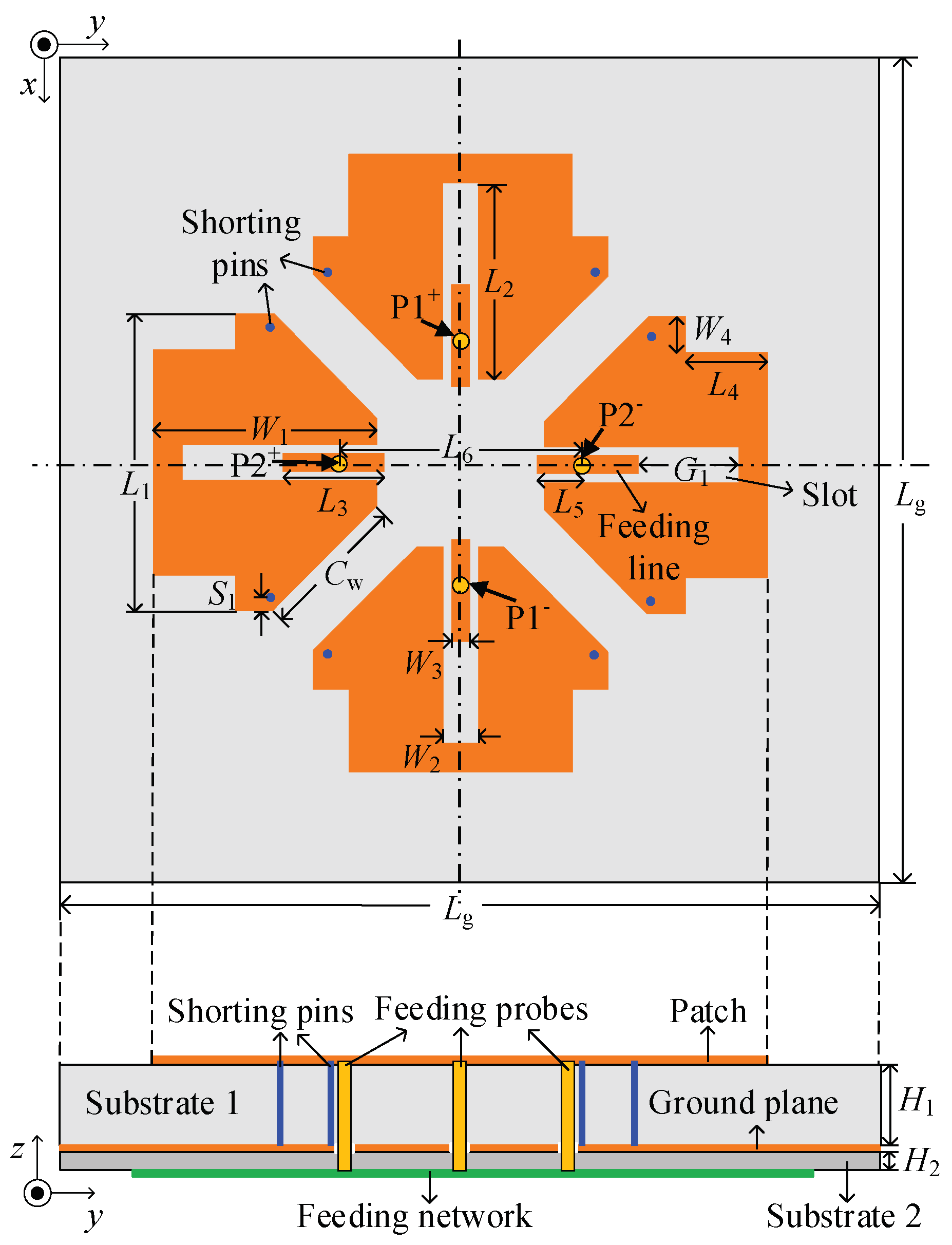


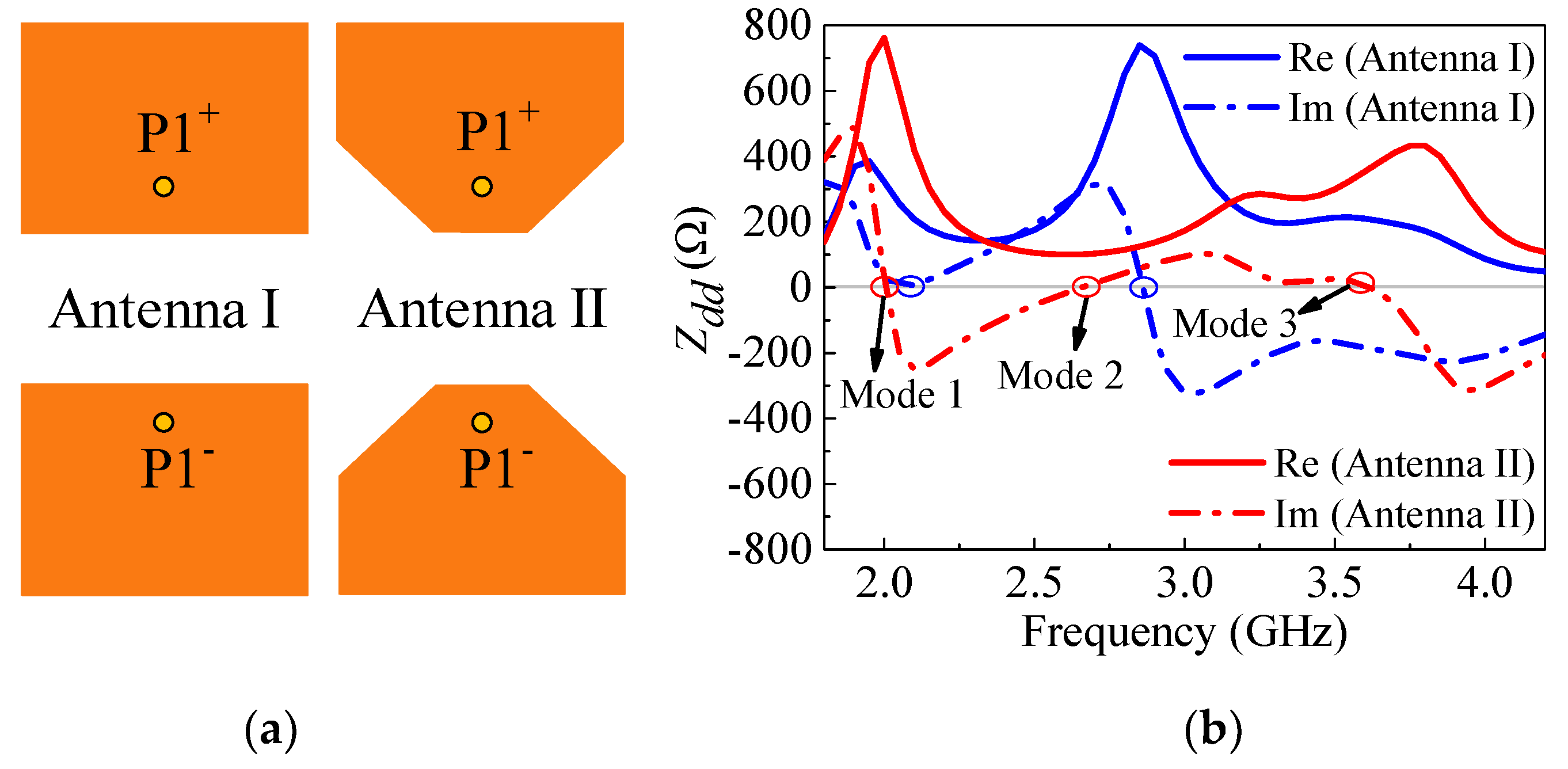
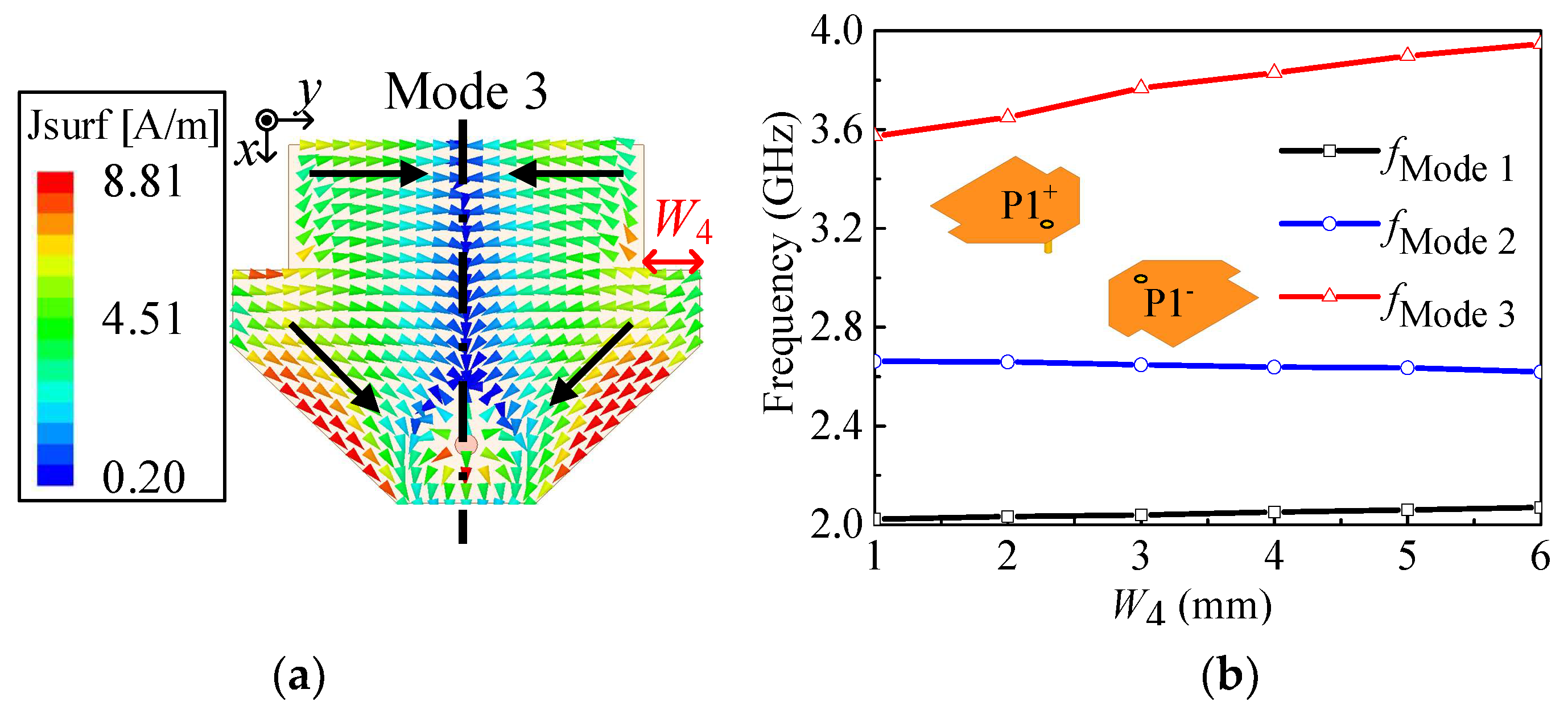
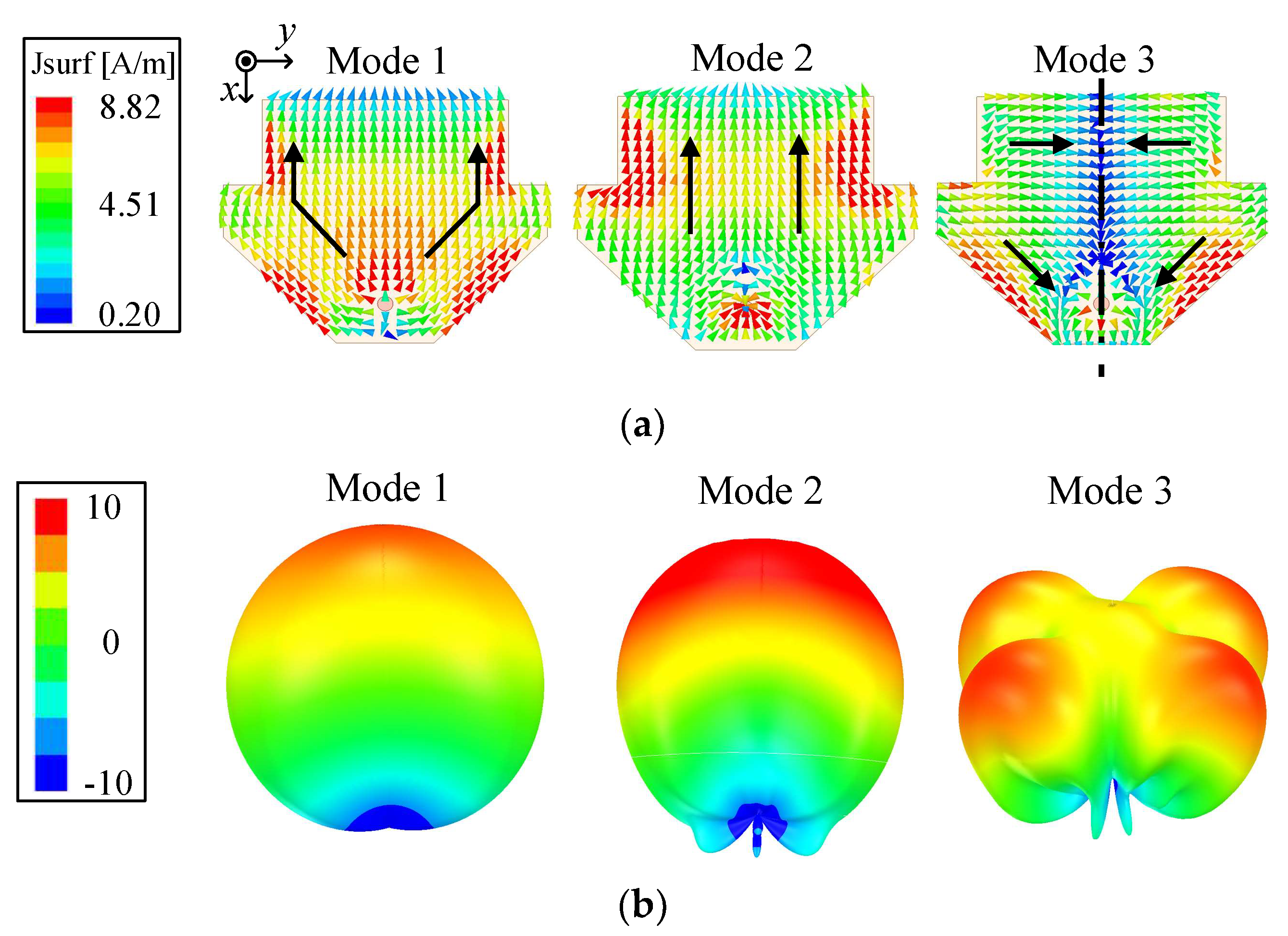


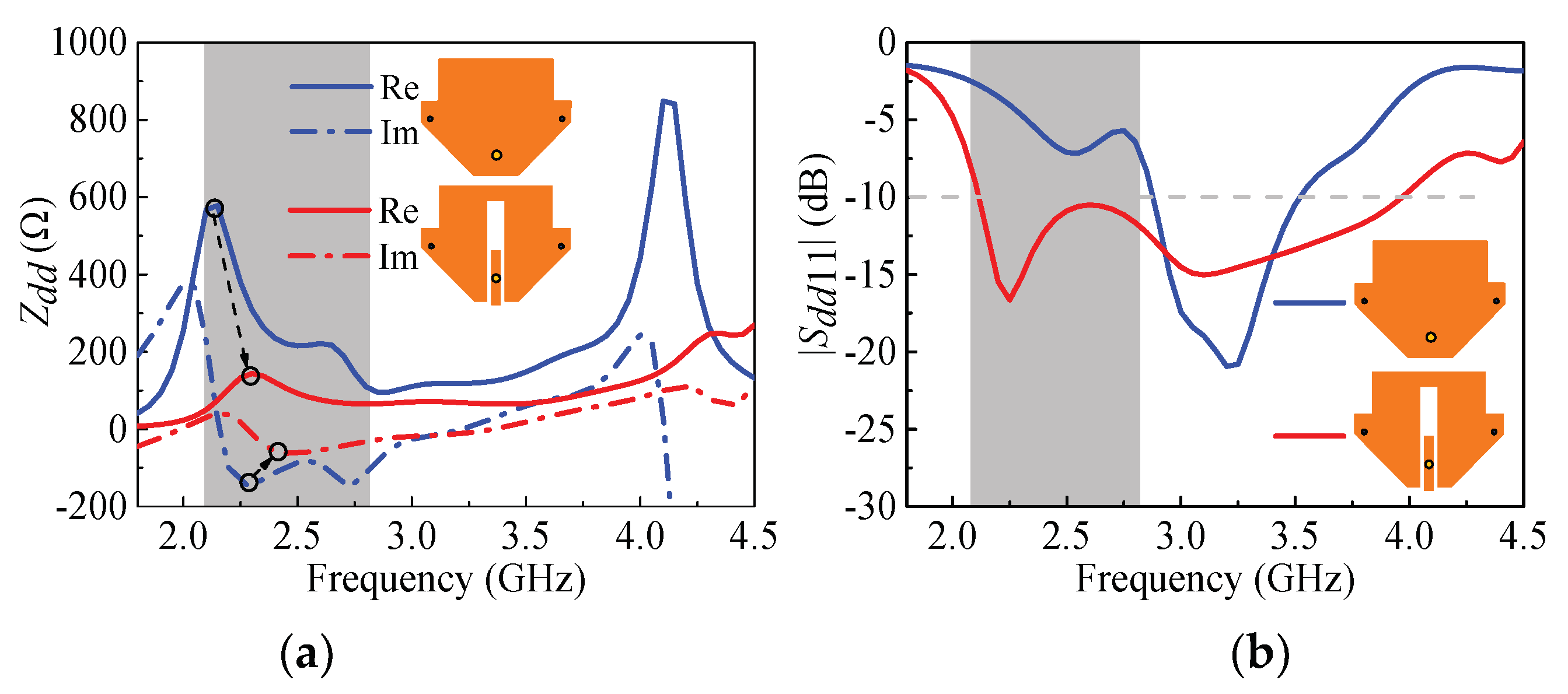
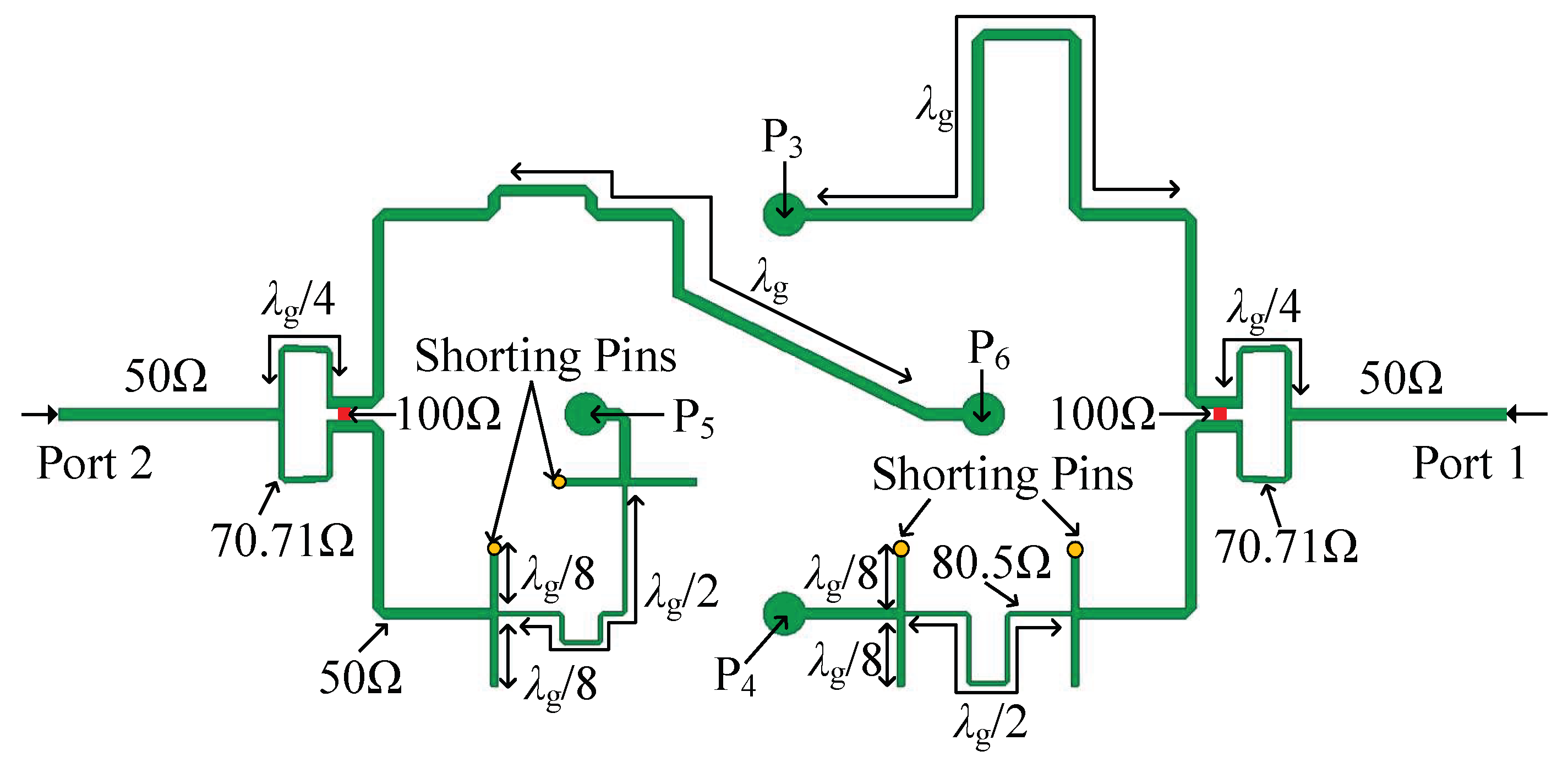

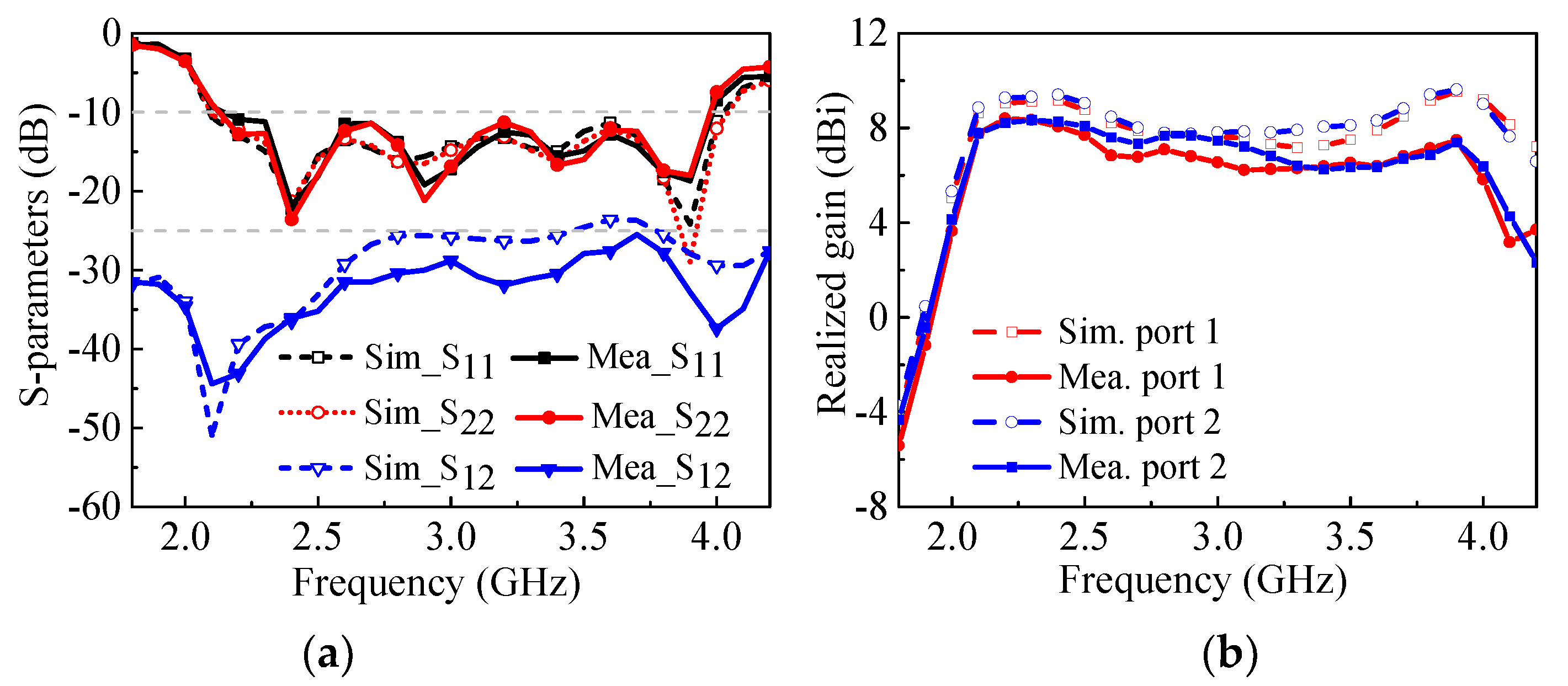
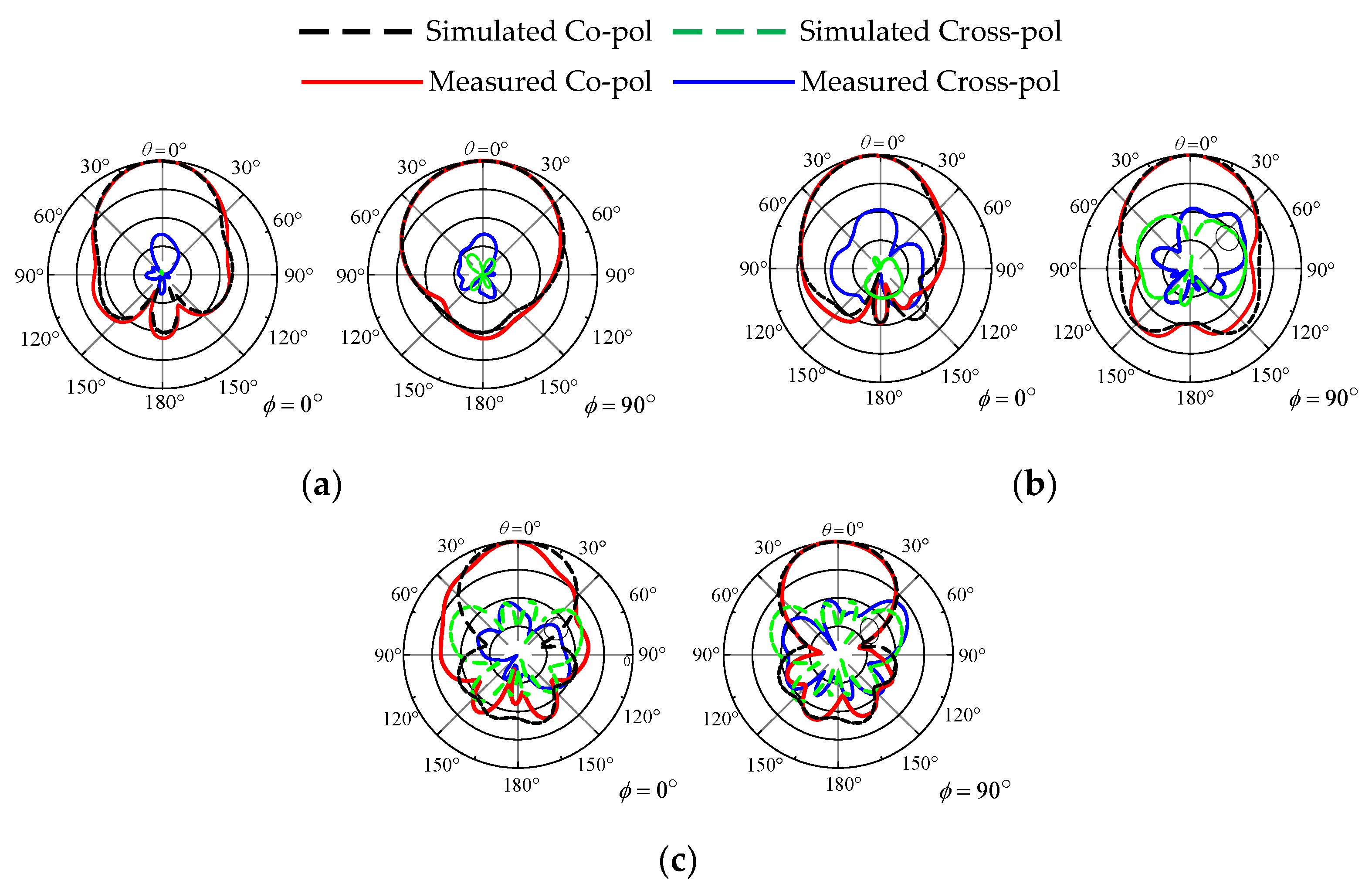
| Parameters | Lg | L1 | W1 | L2 | W2 | L3 | W3 | L4 |
| Value (mm) | 149 | 50 | 38 | 33 | 6 | 17 | 3 | 14 |
| Parameters | L4 | W4 | Cw | L5 | L6 | G1 | H1 | H2 |
| Value (mm) | 14 | 6 | 17.5 | 6.5 | 41 | 17 | 10 | 0.508 |
| Ref. | Bandwidth | Profile (λ0) 1 | Size (λ02) | Isolation (dB) | Gain (dBi) | Type |
|---|---|---|---|---|---|---|
| [4] | 54% (VSWR < 2) | 0.23 | 0.38 × 0.38 | >30 | 7.4 | Patch |
| [9] | 57% (|S11| < −10) | 0.27 | 0.55 × 0.55 | >37 | 8.7 | Patch |
| [17] | 52% (VSWR < 1.5) | 0.26 | 0.58 × 0.58 | >26 | 8.5 | Dipole |
| [21] | 54.8% (|S11| < −10) | 0.13 | 0.78 × 0.78 | >20 | 7.3 | Dipole |
| [22] | 33% (|S11| < −10) | 0.1 | 0.48 × 0.48 | >25 | 8.3 | Dipole |
| [33] | 42.9% (|S11| < −10) | 0.08 | 1.03 × 1.03 | >25 | 9.89 | Dipole |
| This Work | 61% (|S11| < −10) | 0.1 | 1.05 × 1.05 | >25 | 7.31 | Patch |
Disclaimer/Publisher’s Note: The statements, opinions and data contained in all publications are solely those of the individual author(s) and contributor(s) and not of MDPI and/or the editor(s). MDPI and/or the editor(s) disclaim responsibility for any injury to people or property resulting from any ideas, methods, instructions or products referred to in the content. |
© 2023 by the authors. Licensee MDPI, Basel, Switzerland. This article is an open access article distributed under the terms and conditions of the Creative Commons Attribution (CC BY) license (https://creativecommons.org/licenses/by/4.0/).
Share and Cite
Li, Y.; Wei, L.; Wang, K.; Cai, H.; Chen, Z. Low-Profile Wideband Dual-Polarized Patch Antenna Based on Differential-Paired Multi-Mode Arms. Electronics 2023, 12, 2604. https://doi.org/10.3390/electronics12122604
Li Y, Wei L, Wang K, Cai H, Chen Z. Low-Profile Wideband Dual-Polarized Patch Antenna Based on Differential-Paired Multi-Mode Arms. Electronics. 2023; 12(12):2604. https://doi.org/10.3390/electronics12122604
Chicago/Turabian StyleLi, Yuanchun, Lijuan Wei, Kaixu Wang, Hanzhen Cai, and Zihao Chen. 2023. "Low-Profile Wideband Dual-Polarized Patch Antenna Based on Differential-Paired Multi-Mode Arms" Electronics 12, no. 12: 2604. https://doi.org/10.3390/electronics12122604





